Oldfield Park Junior School (Bath) WW1 Memorial Project
WW1 Memorials in Bath Abbey
Bath Abbey's two main memorials to the people of Bath who died in WW1 are:
- The Memorial Chapel in the south-eastern corner of the church
- The Memorial Cloister built against the south aisle (now a gift shop!)
The Abbey is also home to the following:
- Memorials to:
- 4th Battalion, Somerset Light Infantry
- 8th (Service) Battalion, Somerset Light Infantry
- 7th (Service) Battalion, Somerset Light Infantry
- Wessex Royal Engineers
- Bath & Wells Diocesan Association of Change Ringers (bellringers)
- Bath & Wells Diocesan Association of Change Ringers
- Individuals:
- George Hely-Hutchinson Almond (RAMC)
- Aubrey S. T. Reilly (69th Punjabis)
The Memorial Chapel
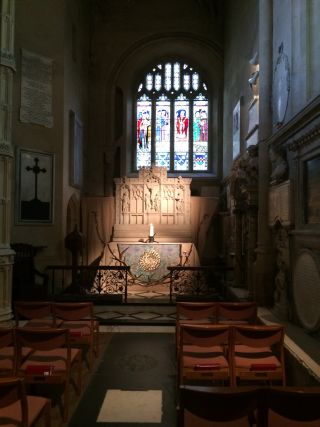
The memorial chapel, now known as the Gethsemane Chapel, above, has a commemorative plaque, seen on the left-hand wall, in the shape of a bronze cross on a marble background.
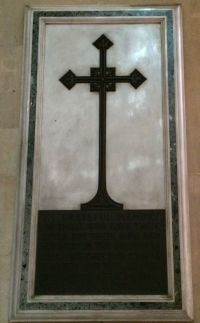
Inscription:
| In grateful memory of those who gave their lives for their King and country in the Great War 1914-1918 this tablet was erected and this chapel was dedicated in the year of our Lord 1923. |
The Memorial Cloister
Now sadly repurposed as a gift shop with no reference to its original dedication
The cloister was dedicated as a War Memorial,
but the Abbey has chosen to relegate this fact to history
In 1919, the choir vestry was located in the south-eastern corner of the Abbey, next to Prior Birde's Chantry. It was a walled-off room within the church. Plans then emerged to create a memorial chapel in this corner, which of course created the need for a new site for the vestry.
The proposal first actively pursued by the Abbey was to house the new vestry underground, beneath the planned Memorial Chapel (to the E of the S transept). When the cost of this became apparent, the church asked the Corporation to surrender some land outside the footprint of the Abbey, to allow the choir vestry to be built out into the public thoroughfare in Kingston Buildings (again, E of the S transept). The Corporation Surveying Committee went to the trouble of constructing of a wood-and-canvas structure of the suggested size, in order to show the extent of the likely works and their impact on the public right of way in Kingston Buildings. This done, they did not assent to the public land being ceded to the church for the project and in fact gave reasons of aesthetics as the key reason for rejection of the plan. The project in this form was therefore shelved in December 1919.
Spring 1920 saw the submission of a new design for the choir vestry. This was in an entirely different location, now to the W of the S transept, all within the Abbey's railed-off footprint. The extension would provide a vestry and additional space and was referred to as a 'cloister'. The plans remained part of a single project that included the Memorial Chapel; the whole was referred to throughout as the Bath Abbey War Memorial Project, for which there was public fundraising etc.
Throughout the discussion of proposals for the creation of a new vestry etc., it was repeatedly asserted how great the need for a new vestry was, with church meetings being held in cramped conditions in the existing vestry of the clergy and sometimes awith mutual inconvenience. This highlights one aspect of an interesting debate that raged in these times, namely whether it was appropriate to use the notion of a 'memorial' to have something constructed for which a specific need was felt. Detractors were quick to argue - not just in this case, but replicated many times in towns, villages and societies all over the nation - that it was disingenuous to seek public subscriptions for a 'memorial' and to then use this money for a scheme which was of benefit to the living, or which would in any event have been necessary. This is, however, what ultimately happened at the Abbey, as it also did, for example, with the creation of a sports complex as the Stothert & Pitt memorial.
The plans for the Abbey were approved in the autumn of 1921 and building on the cloister commenced in August 1922. Work on the creation of the Memorial Chapel on the site of the old vestry commenced in May 1923 and it was dedicated later that year.
The vestry was skilfully designed (the architect was Sir Thomas Jackson) such that it did not block a single window and required a minimum of alteration to the existing fabric of the church, using as it did an existing doorway - the old Prior's door - in the south aisle. The work was completed by Hayward & Wooster.
During the fundraising stage...
"...the Committee expressed the hope, and it will certainly be complied with, that when the cloister has been completed, it should bear on its interior wall some clear and prominent statement that the whole cloister is a memorial by the people of Bath and its neighbourhood to those who fell in the Great War, 1914-18, or who died from wounds or disease subsequently. it will be in fact a very definite Bath war memorial, just as the memorial chapel is." [Bath Chronicle & Weekly Gazette, 9th August 1924]
The cloister was completed externally in 1926 and internally some time later. It was dedicated on Armistice Day 1927 by the Bishop of Bath & Wells. The report in the following day's newspaper included the words:
"The new cloister is intended to be a memorial to all who fell in the Great War additional to the Memorial Chapel at the east end of the south choir aisle dedicated some years ago." [Bath Chronicle & Weekly Gazette, 11th November 1927]. The Western Daily Press also carried a piece called 'Bath's War Memorial Cloister Opened'. The Chronicle, in its annual review in December 1927, recalled the dedication of the new War Memorial Cloister at the Abbey.
Today there is no recognition of the fact by the Abbey that the cloister ever had a memorial function and any inscription or plaque, such as must surely have been installed on its dedication is now hidden or has been removed.
Other memorials in Bath Abbey
4th Battalion, Somerset Light Infantry
Not currently reliably accessible
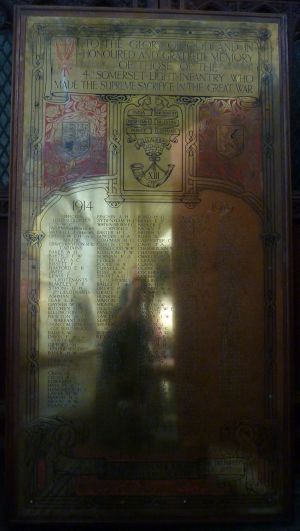
4th Battalion, Somerset Light Infantry
Not currently reliably accessible

Inscription:
"To the Glory of God and in honoured and grateful memory of those of the 4th Somerset Light Infantry who made the supreme sacrifice in the Great War"
Individual names to follow
"To the Glory of God and in honoured and grateful memory of those of the 4th Somerset Light Infantry who made the supreme sacrifice in the Great War"
Individual names to follow
The 4th Somersets was the battalion most closely associated with the city in WW1.
The memorial to the fallen soldiers of the 4th Somersets was originally affixed to the wall in the north transept. The north transept of the Abbey is now behind a wooden screen and memorials in this area cannot usually be accessed. The memorial was taken down from the wall; we are told that this was in order to make it accessible for people to view. In the summer of 2014, it was however languishing in the St Alphege chapel, behind a heavy screen and obscured by stacked chairs and cardboard boxes.
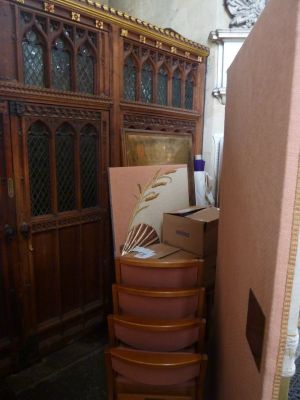
The memorial was brought out for the Vigil service on 4th August 2014, which took place in the Abbey to mark the centenary of the commencement of WW1. This was a wonderful and very poignant event at which the memorial served as an important visual aid, positioned in pride of place inside the west door and surrounded by candles.
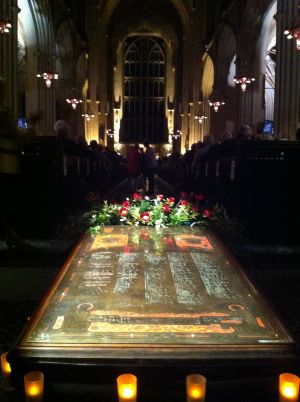
For some time following the Vigil service, the memorial was to be found leaning against the wall in the Gethsemane Chapel (or Memorial Chapel) in the SE corner of the Abbey. However, on recent visits to the Abbey (latest in February 2016), the memorial is again nowhere to be seen. This at a time when we are marking the centenary of WW1.
The WW1-era Colours of the 4th SLI are also deposited in the Abbey and hang in the south aisle. The plaque explaining this is sadly obscured by straps securing audiovisual equipment.
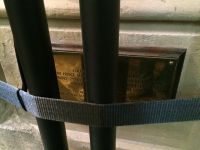
The memorial to the fallen soldiers of the 4th Somersets was originally affixed to the wall in the north transept. The north transept of the Abbey is now behind a wooden screen and memorials in this area cannot usually be accessed. The memorial was taken down from the wall; we are told that this was in order to make it accessible for people to view. In the summer of 2014, it was however languishing in the St Alphege chapel, behind a heavy screen and obscured by stacked chairs and cardboard boxes.

The memorial was brought out for the Vigil service on 4th August 2014, which took place in the Abbey to mark the centenary of the commencement of WW1. This was a wonderful and very poignant event at which the memorial served as an important visual aid, positioned in pride of place inside the west door and surrounded by candles.

For some time following the Vigil service, the memorial was to be found leaning against the wall in the Gethsemane Chapel (or Memorial Chapel) in the SE corner of the Abbey. However, on recent visits to the Abbey (latest in February 2016), the memorial is again nowhere to be seen. This at a time when we are marking the centenary of WW1.
The WW1-era Colours of the 4th SLI are also deposited in the Abbey and hang in the south aisle. The plaque explaining this is sadly obscured by straps securing audiovisual equipment.

8th Battalion, Somerset Light Infantry
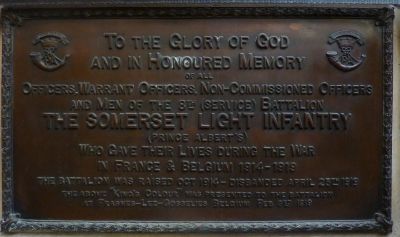

In
the north aisle of the Abbey are the Colours of the 8th SLI presented
to the battalion in 1919 to mark its contribution to the Final Push.
The above plaque is on a pillar near the Abbey entrance, but no names
are included.
Inscription:
"To the Glory of God and in Honoured Memory of all Officers, Warrant Officers, Non-Commissioned Officers and Men of the 8th (Service) Battalion, the Somerset Light Infantry (Prince Albert's) who gave their lives during the War in France & Belgium 1914-1919. The Battalion was raised Oct 1914 - disbanded April 23rd 1919. The above King's Colour was presented to the battalion at Frasnes-les-GosseliesFeb 3rd 1919".
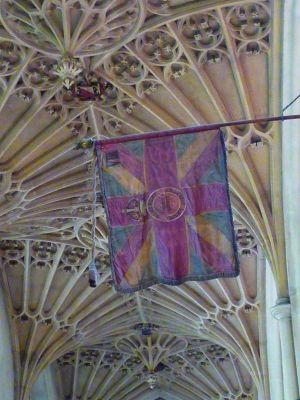
7th Battalion, Somerset Light Infantry
The Abbey also received the Colour of the SLI 7th Bn. This hangs in the north aisle.
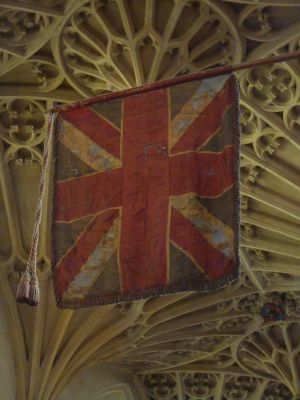
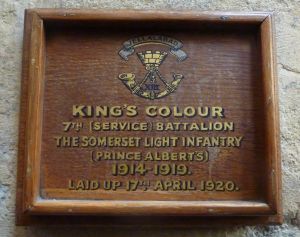
1st (Wessex) Royal Engineers
Currently inaccessible
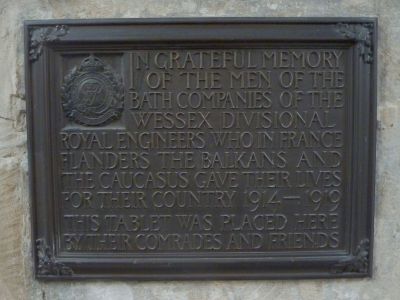
Inscription:
"To the Glory of God and in Honoured Memory of all Officers, Warrant Officers, Non-Commissioned Officers and Men of the 8th (Service) Battalion, the Somerset Light Infantry (Prince Albert's) who gave their lives during the War in France & Belgium 1914-1919. The Battalion was raised Oct 1914 - disbanded April 23rd 1919. The above King's Colour was presented to the battalion at Frasnes-les-GosseliesFeb 3rd 1919".

7th Battalion, Somerset Light Infantry
The Abbey also received the Colour of the SLI 7th Bn. This hangs in the north aisle.


1st (Wessex) Royal Engineers
Currently inaccessible

The
memorial plaque for the Wessex RE is on the wall of the north transept,
behind a locked screen and cannot be accessed at the current time.
Inscription:
"In grateful memory of the men of the Bath companies of the Wessex Divisional Royal Engineers who in France, Flanders, the Balkans and the Caucasus gave their lives for their country 1914-1919. this tablet was placed here by their comrades and friends."
See the stories of Sapper Ernest Mundy and Sapper Ernest West who both served with the Wessex RE.
Inscription:
"In grateful memory of the men of the Bath companies of the Wessex Divisional Royal Engineers who in France, Flanders, the Balkans and the Caucasus gave their lives for their country 1914-1919. this tablet was placed here by their comrades and friends."
See the stories of Sapper Ernest Mundy and Sapper Ernest West who both served with the Wessex RE.